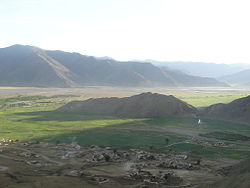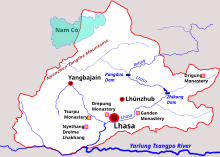
Back نهر لهاسا ARZ لهاسا چایی AZB Лхаса (река) Bulgarian Lhasa He CEB Kjičhu Czech Lhasa He German Río Lhasa Spanish Lhasa (joki) Finnish Kyi chu French ラサ川 Japanese
| Lhasa River | |
|---|---|
 Lhasa River near Ganden Monastery 1 (December 2006) | |
 | |
| Etymology | River of Felicity[1] |
| Location | |
| Autonomous region | Tibet |
| Physical characteristics | |
| Source | |
| • location | Nyenchen Tanglha Mountains |
| • coordinates | 30°11′12″N 91°20′41″E / 30.1868°N 91.3448°E |
| • elevation | 5,290 m (17,360 ft) |
| Mouth | |
• coordinates | 29°20′27″N 90°45′38″E / 29.34083°N 90.76056°E |
• elevation | 3,590 m (11,780 ft) |
| Length | 450 km (280 mi) |
| Basin size | 26,000 km2 (10,000 sq mi) |
| Discharge | |
| • average | 335 m3/s (11,800 cu ft/s)[2] |
| Basin features | |
| River system | Brahmaputra River |
| Tributaries | |
| • left | Reting |
| • right | Phak, Phongdolha, Pengbo, Duilong |
The Lhasa River, also called Kyi Chu (Tibetan: སྐྱིད་ཆུ་, Wylie: sKyid chu, Chinese: 拉薩河; pinyin: Lāsà hé), is a northern tributary of the Yarlung Tsangpo River in the south of the Tibet Autonomous Region of China. The Yarlung Tsangpo is the upper section of the Brahmaputra River. The Lhasa River is subject to flooding with the summer monsoon rains, and structures have been built to control the floods. In its lower reaches the river valley is an important agricultural area. The city of Lhasa lies on the river. There are two large hydroelectric power stations on the river, the Zhikong Hydro Power Station (100 MW) and the Pangduo Hydro Power Station (160 MW)
- ^ McGovern 1924, p. 268.
- ^ Shen 1995, p. 151.
© MMXXIII Rich X Search. We shall prevail. All rights reserved. Rich X Search